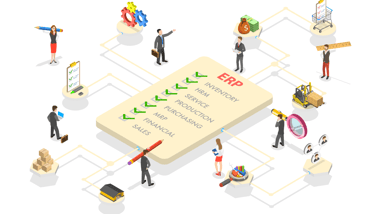With current market volatility, many companies are finding it crucial to set up and maintain a Cash Flow Forecast. Sustainable growth and navigating the economy during a recession is near impossible without it.
You should always be in a position to monitor your cash and model scenarios on how underlying assumptions such as changes in the workforce, demand, sales, and budgets can impact your cash. Understanding whether or not plans are feasible is crucial to minimizing business risk.
Fortunately, there are several planning methods to consider to help you get through common challenges and stay on top of cash flow.
The Challenges of Managing Cash Flow Forecasting
Cash Flow is the lifeblood of any organization. It is critical that management can effectively forecast the current state of cash, so they can meet their short and long-term operational needs. So how does a company keep track of Cash Flow with so many underlying assumptions changing constantly?The fundamental problems in accurately managing Cash Flow Forecasting have not changed over the years but the complexity of evolving businesses has. Nearly 80% of our clients have encountered the following challenges when it comes to Cash Flow Forecasting:
- Disjointed processes
- Risk of errors
- Poor communication between departments (treasury, accounting, FP&A, management, etc.)
- Delayed visibility of Cash Flows
- Time-consuming preparation processes, making Cash Flow forecasts irrelevant by the time it is completed
- Reports not aligning with the actual management of cash accounts by the treasury
In order to manage Cash Flow Forecasting effectively we need to ask ourselves the following questions:
- What does Cash Flow Forecasting really mean to us and our organization?
- How can accurate forecasting avoid potential pitfalls, reduce borrowing costs and invest excess cash in other strategic initiatives?
- How can effective Cash Flow Forecasting drive our business success?
- Is our current Cash Flow process ready to grow and change with our business?
- How much time do we spend on our current process?
- Are we still using Excel to manually manage our Cash Flow Forecasting and is there a modern tool that can help?
As you know for Cash Flow Forecasting, effective planning is critical when trying to keep up with cash obligations and changes in your daily operations. Long, manual reporting cycles can leave you well behind the competition as well as the demands of your customers, whose loyalty you don’t want to compromise. Effective Cash Flow Forecasting allows internal and external stakeholders to achieve their objectives in planning and allocating resources.
Cash Flow for Recession
Given the importance of Cash Flow forecasting during the recession, companies must evaluate their cash flow requirements, develop appropriate actions for various scenarios, and assess potential risks to their customer base and supplier network.
Some questions organizations should ask themselves are:
- What portions of the business have been impacted by the recession?
- Do we have delayed close cycles on sales orders?
- What is the impact on the supply chain — and what are all the potential ranges of that impact based on both manufacturing and customer locations?
- How have customer buying habits changed by region or product category?
Keeping these questions in mind, finance teams can begin to make plans around cash flow. Companies should be developing a treasury plan for cash management as part of their overall business risk and continuity plan.
Especially in these circumstances, teams cannot assume the same financing options will be available. Scenario planning should be done to better understand how much cash the business will need heading into the new year.
Obtaining sustainable savings will likely require more visibility into the supply chain and inventory, as well as improvements to production planning and scheduling. A system that incorporates data from your various sources is needed to achieve fully integrated planning and make the best decisions during this time.
Introducing Limelight Cash Flow Forecasting
We recommend using Limelight for an integrated approach to speed up planning and reporting cycle times through the use of our latest technology for Cash Flow Forecasting. Construct your Cash Flow Forecast from your own financial and non-financial data to make intelligent decisions based on the latest data, using predictive modeling techniques and manual overrides for management adjustments.
Limelight’s Cash Flow Forecasting solution approaches the problem from the balance sheet planning perspective. You can simulate different scenarios in real-time to effectively make business decisions and approach the problem with a holistic approach. The process starts with forecasting the balance sheet with accurate and real-time data using historical trends, financial ratios, and management adjustment layers. Users no longer need to manually work backward from the balance sheet to prepare a Cash Flow statement. In Limelight, the two statements are prepared in parallel, with the accuracy and data stakeholders need to get a complete view of their company’s financial health.
Limelight’s advanced features and functionality can yield the following benefits:
- Standardize your Cash Flow reporting by integrating financial statement preparation
- Better management of cash obligations
- Maximized yields on investments
- Intelligent inter-company cash allocation decisions
- Streamlined planning for future investments
- Improved financial governance and compliance
- Use dashboards/charts to show key metrics displayed in real-time
As a cloud-based solution, Limelight is easy to deploy across your organization. It integrates with your data sources and uses the Excel features you and your team know and love.
To see Limelight in action, book a tailored demonstration with our experts today!






